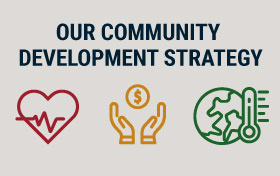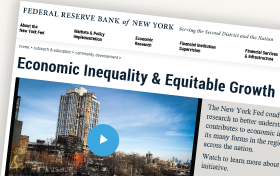Good morning and welcome once again to the New York Fed’s Regional Economic Press Briefing. I am pleased to have this opportunity to speak with you—and, through you, to the people in our District. I am going to discuss conditions in the national economy and then on conditions in our region, with a focus on private, for-profit institutions, which have become more visible in the U.S. higher education market.
As always, what I have to say reflects my own views and not necessarily those of the Federal Open Market Committee (FOMC) or the Federal Reserve System.
National Economic Conditions
Let me begin by taking stock of where we are at the moment. Then I will address my expectations for the performance of the economy in 2014 and 2015.
Since the end of what is now called the Great Recession in mid-2009, the U.S. economy has experienced 17 consecutive calendar quarters of positive growth of real GDP (gross domestic product). However, the compound annual rate of growth over that period has only been around 2¼ percent, close to prevailing estimates of the economy’s potential growth rate. Thus, we have made limited progress in closing the substantial output gap that was created during the recession.
A similar conclusion is drawn from an assessment of labor market conditions. Although the unemployment rate has declined by about 2 ¾ percentage points since peaking at 10 percent in October of 2009, a significant portion of that decline reflects the substantial decline of the labor force participation rate over that period. It should also be noted that since the previous business cycle peak at the end of 2007, the decline of the labor force participation rate has been more than accounted for by a decline in participation of people in the prime working age of 25 to 54.
The inflation data are also consistent with this overall picture of an economy operating well below its full potential. Total inflation, as measured by the personal consumption expenditures (PCE) deflator, has been quite volatile in recent years due to sharp fluctuations in energy prices. Core inflation, which excludes the volatile food and energy components and thereby may be a better guide as to underlying inflation, slowed from around 2 percent in early 2012 to just above 1 percent in mid-2013. In recent months it has shown signs of stabilizing, but remains well below the FOMC’s expressed goal of 2 percent for total inflation. Fortunately, inflation expectations remain relatively stable at levels somewhat above the current inflation rate. This stability should help prevent an undesirable further drop in inflation relative to our 2 percent objective.
That said, there are some nascent signs that the economy may be doing better. For example, based on the first estimate, which is subject to revision, real GDP increased at a 2.8 percent annual rate in the third quarter of 2013, above the trend of the past four years. And the most recent payroll employment report showed a pickup in the monthly pace of job gains. The 3-month moving average rose back above a 200,000 pace after slowing to about 150,000 as of July of this year. I hope that this marks a turning point for the economy.
But before we rush to this conclusion, a few more cautionary comments are appropriate. With respect to GDP growth, it turns out that inventory investment contributed ¾ of a percentage point to that overall growth rate. Thus, because this impetus from inventories will likely reverse this quarter, the real GDP growth rate is likely to slow to around a 2 percent annual rate or a bit less in the fourth quarter. With respect to payroll employment, we have seen such bursts in payroll growth before over the past few years and have been disappointed when the pickups proved temporary and did not lead to a rise in the overall growth rate.
But, I have to admit that I am getting more hopeful. Not only do we have some better data in hand, but also the fiscal drag, which has been holding the economy back, is likely to abate considerably over the next few years at the same time that the fundamental underpinnings of the economy are improving.
The first thing to note is that federal fiscal policy in 2013 has been unusually contractionary. At the beginning of the year the payroll tax cut expired while tax rates on higher income households were raised, a series of taxes associated with the Affordable Care Act took effect, and spending was reduced due to the sequester and the gradual winding down of foreign military operations. According to the Congressional Budget Office, the cyclically-adjusted or full-employment budget balance increased by roughly 1 ¾ percentage points of GDP in fiscal year 2013. Over the past 50 years there have been only two other episodes of fiscal contraction of this order of magnitude, and both of those occurred when the unemployment rate was substantially lower than it has been of late. Under current law, the amount of federal fiscal restraint will decline in 2014 and then decline further in 2015. At the same time, the sustained contraction in spending and employment by state and local governments appears to be over.
The fact that the U.S. economy has continued to grow at around a 2 percent pace in 2013 despite this quite intense fiscal restraint provides evidence to the second key point, which is that the private sector of the economy has largely completed its healing process and is now poised to ramp up its level of activity. Key measures of household leverage have declined and are now near the lowest levels they have been in well over a decade. Household net worth, expressed as a percent of disposable income, has increased back to its average of the previous decade, reflecting rising equity and home prices and declining debt. Recently, banks have eased credit standards somewhat after a prolonged period of tightness. As a result, we are now experiencing a fairly typical cyclical recovery of consumer spending on durable goods. For example, sales of light-weight motor vehicles have increased steadily over the past four years, reaching an annual rate of 15.7 million in the third quarter of 2013, though sales in September and October have been somewhat below that average.
Similarly, after five years in which housing production was well below what is consistent with underlying demographic trends and the replacement demand for houses, it now appears that we have worked off the excess supply of housing built up during the boom years of the last decade. Housing market activity has begun to recover, and a widely followed national home price index is up 12 percent over the 12 months ending in September.1 Anecdotal reports suggest that this higher-than-expected increase in home prices is due to a relatively low number of homes for sale. Due to this shortness of supply, there is reason to expect increases in starts going forward.
Yet another bright spot on the horizon is the fact that growth prospects among our major trading partners have improved following a few years of lackluster performance which induced a sharp slowing of growth of U.S. exports. In particular, the euro area appears to have emerged from a protracted recession and is experiencing modest but positive growth.
To summarize, while growth in 2013 has been disappointing, I believe a good case can be made that the pace of growth will pick up some in 2014 and then somewhat more in 2015. The private sector of the economy should continue to heal, while the amount of fiscal drag should subside. Despite near-term concerns, growth prospects among our major trading partners will improve further next year. This combination of events is likely to create an environment in which business investment spending will strengthen. As growth picks up, I expect to see more substantial improvement in labor market conditions and a gradual updrift in inflation back towards the FOMC’s target rate.
However, the notion that the economy will grow more swiftly remains a forecast rather than a reality at this point. As is always the case, there is substantial uncertainty surrounding this forecast. Moreover, there is always the possibility of some unforeseen shock. Thus, we will continue to monitor U.S. and global economic conditions very carefully and will adjust our views on the likely path for growth, inflation and the unemployment rate accordingly.
Regional Economic Conditions
Let me turn now to the regional economy. A year has passed since Superstorm Sandy devastated the tri-state region. And even today, many of the hardest-hit places are still struggling to recover and rebuild from the storm. In fact, reminders of the storm’s damage remain visible in neighborhoods across Brooklyn, Queens and Staten Island, as well as along the coasts of Long Island and New Jersey. On a more encouraging note, however, the broader regional economy has proven to be remarkably resilient. After a brief dip following the storm, the regional economy quickly rebounded and has continued to add jobs at a reasonably good pace. Moreover, the region’s housing markets have continued to show steady improvement throughout the year.
To help monitor the performance of the regional economy more generally, the New York Fed produces economic activity indexes for New York State, New York City and New Jersey. Based on these measures, New York City’s economy has continued to grow strongly throughout the year, and both New York State and New Jersey have seen some pickup in growth in recent months. As a result, a growing number of places in the region have either recovered or are close to recovering the jobs that were lost during the Great Recession.
More troubling, however, is that Puerto Rico’s economy remains exceptionally weak; activity and employment on the Island continue to decline. Our economists will elaborate on these trends this morning.
Private For Profit Institutions in the Higher Education Landscape
The important role of post-secondary education is undeniable given the key role that human capital plays in economic growth. However, the higher education landscape comprises different types of post-secondary institutions that provide different educational experiences. One such group of institutions—private for-profit institutions—have progressively become more visible in the U.S. higher education market. For-profit institutions and their growth in the market for student loans and federal need-based aid is the subject of the special topic in today’s briefing.
Analysis done here at the New York Fed reveals that enrollment in for-profit colleges showed explosive growth nationally during, and for some time after, the Great Recession. Interestingly, this growth in enrollment has leveled off perceptibly as the economic recovery has taken hold. These patterns suggest that workers who were displaced from their jobs during the Great Recession chose to enroll in two-year and less-than-two-year colleges, mostly in for-profits but also in public community colleges. Now, with improved labor market conditions, individuals have less reason to get a short-term degree or may have returned to the labor force.
Stark patterns are also observed in the market for student loans. Both the incidence of student loans and average loan size are by far greater in for-profit institutions than in comparable public colleges. Given the importance of post-secondary education in our nation’s future, and the key role that human capital plays in our nation’s growth, we at the New York Fed will continue to analyze the growth of the private for-profits in particular, and post-secondary institutions in general, in our region and the nation.
I will now ask Jaison Abel to discuss economic conditions in our region.
1 Based on the CoreLogic home price index including distressed sales.












